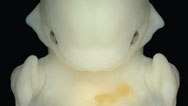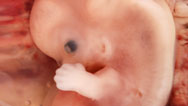Gene Switches
- By Nipam Patel
- Posted 08.01.07
- NOVA
Some genes in our genome act as switches, turning other genes on
or off at different times and for different lengths of time. In
an animal's embryonic stage, these gene switches play a
predominant role in laying out the animal's basic body plan and
perform other early functions. In this slide show, you'll see a
striking example–in that lab standard
Drosophila melanogaster, the
fruit fly–of just how powerful these embryonic gene
switches can be.
Nipam Patel is a professor in the Departments of Molecular and
Cell Biology and Integrative Biology at UC Berkeley and runs a
research laboratory that studies the role, during embryonic
development, of homeotic genes (the genetic switches described
in this slide show).
Credits
Images
- (cardiac muscle cells)
- © Lester V. Bergman/CORBIS
- (nerve cells)
- © Image Source/Corbis
- (red blood cells)
- © Micro Discovery/Corbis
- (Hox genes of fly, Hox genes of mouse)
-
adapted by Cold Spring Harbor Laboratory Press/original
image © Sinauer Associates, Inc.
-
(stained fly embryo, fly images, imaginal disk images)
- Courtesy Nipam Patel
- (baby)
- © Julie Merchant/istockphoto.com
Related Links
-

Cliff Tabin defines the new field of "evo devo" and some of
the groundbreaking discoveries he and others have made.
-

See if you can tell what four similar-looking embryos will
become, and watch each develop.
-

In this interactive, see how closely parts of your body match
those in other animals, from sharks to fruit flies.
-

How do you get from genes to behavior (and back again)?
Close
You need the Flash Player plug-in to view this content.






